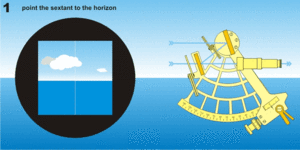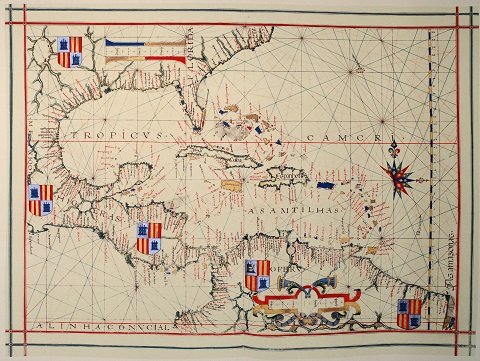The Journey at Sea #1 What it took

Anyone who has watched the movie Pirates of the Caribbean must have seen the amazing navigational skills that the character Jack Sparrow exhibited while sailing at sea. It is obvious from the movie and even in a life situation that sailing at sea isn't so easy as it seems, there are no signboards, carved out tracks, or even a big shinning traffic light directing traffic at sea but still, sailors manage to find their way.
And being a curious person, I decided to dig deep into navigation at sea, uncover the hidden secret and bring to light forgotten knowledge. Not that I am the best researcher but I hope to share useful knowledge. So stick with me as I share with you want I learned.
Obviously, from the medieval period and far back, and even up till now, there have been advancements in the process of navigation at sea but for the first part of this series, I will like to examine the navigational process of old before looking at what has changed.
Navigation of Old
The Stars and Sun
One of the earliest methods of navigation known to sailors was the use of celestial bodies like the sun and the stars. Getting lost at sea was not an option for them, so they had to use their surrounding environment, and what more than the sun and stars which were always there. They used the sun to guide their journey during the day and the stars during the night.
They very much knew that the sun rose in the east and sets in the west, so they used this knowledge to guide their journey. They knew that if they traveled into the rising the sun they were heading east and if they turned left, putting the rising sun at their left, that they were traveling to the north. Sure, even with this knowledge they could not estimate the distance to be covered.
By locating the North Star, Polaris, sailors were able to journey during the night and not get lost. The North star, Polaris, could always be found at a fixed point in the northern hemisphere at all times and all other stars seemed to rotate around it. From experience, they noticed that whenever they traveled further North in the Northern hemisphere, the higher the North star appeared and whenever they traveled further south in the northern hemisphere the lower the North star appeared.
Many sailors of old used a handy tool to help measure precisely how high or low a star was in the sky: their fingers! By holding his arms straight out in front of him, a mariner laid his fingers on top of each other to measure the “height” of a star such as the North Star from the horizon. Because the height of Polaris above the horizon is equal to the latitude at a particular location, sailors could use the star to estimate their location. They would, for example, turn west or east once a particular star selected for navigation was two finger widths above the horizon.
Mariners Compass
Obviously, the use of compass didn't start today or yesterday. Sailors have been using compasses for a long time, even as far back as 1200 AD but possibly not as we know it today. Compasses of different form have been in use even before then, the basic idea was a device that pointed North at all times.
Before the compass, sailors used a lodestone to help find their direction at sea. There were two main ways to use a lodestone. The first was to hang it from a string and allow it to turn and point north. The second was to float it on a piece of wood in a bowl of water, where it would drift towards the north. Most sailors used the water method because when they were standing on the deck of a moving ship it was hard to keep the string from swinging around too much.

Some of the early compasses Mariners used were made from a magnet or a magnetized needle on a card with four or eight points of direction. The points of direction on the card were based on the direction of the wind relative to the magnet and often time they just sailed with the wind that blew in the direction they wanted to go.
Nautical Charts
Some mariners after having journeyed across the seas for years started keeping records of places they encountered during their journey, some even went as far as putting it down in drawings or charts. This gave birth to the first nautical charts.
Nautical charts only showed the representation of hydrographic data and were meant to give information such as water depths, tide predictions and any obstruction that would or could be encountered at sea such as rocks, shipwrecks etc. This charts were not so accurate but were the most treasured property a sailor could possess because it offered anyone who had it a certain advantage at sea. For example, in case of war, only those who had this charts could easily maneuver their way in the waters and hide behind a rock they knew existed there.
Unlike regular maps, there was no latitude or longitude on a nautical chart. To determine the direction to take they would use the compass rose they previously attached to the charts. The compass rose was nothing more than the figure of a compass with points and only showed them the direction to take between major ports.
Use of Sexant
As I mentioned earlier mariners used their hands to determine how high or low the North Star was from the horizon, with time they developed devices that would help them determine this same information easier and more accurately. One of such devices was the Sexant.
By lifting the sextant to the horizon and moving the index bar so that the index mirror aligns the sun or star with the horizon, the Mariners could estimate the angle between the star and the horizon thus determining the altitude and latitude of a given location. This process was called Sighting

With the knowledge of the angle and the time of measurement, they could calculate a position line on a nautical chart. The sextant was not the best instrument because of all the errors that came alongside using a mirror, but it was helpful and required little technical know how to operate it.
One of the very first people to implement the principle of a sextant according to Wikipedia was John Hardley and Thomas Godfrey, but there are other sources stating the contrary.
Conclusion
After everything we have seen so far we can say that sailors didn't just hop into their boats or ships and started sailing without direction. Starting off with the use of the sun and the stars to determine the direction to sail, to using their hands to determine the latitude of their given location, to using devices like compass or sextant to make the process a lot easier.
Obviously, this post doesn't serve as a History book of Sailing at Sea but gives us a glimpse of what it took to journey using a boat or ship in the old days.
Reference:
Image Credit
- All images links and credit are given below each image.



Great read. I've been catching up on Vikings and find my self wondering how the hell they found their way constantly. They did the thing with the "sun stone" in the first season, but from then on, they just hopped in a boat and poof France, poof, Iceland. This stuff is what made Vikings and pirates worth talking about.